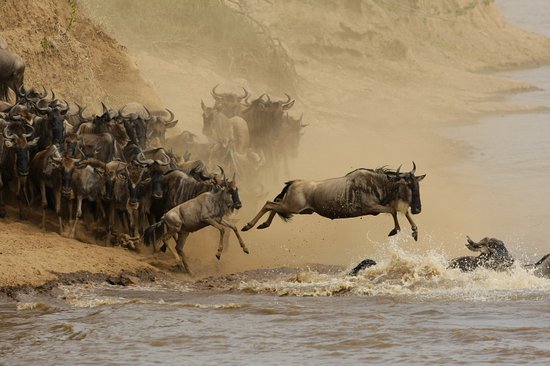Great Migration is the ever-moving circular migration of over a million animals across the Serengeti-Mara ecosystem. The ever-moving columns of wildebeest, joined by a host of companions, follow an age-old route in search of grazing and water. This journey takes them across the plains of the Maasai Mara Safari in Kenya, all the way south into Tanzania, through the Serengeti to the edge of the Ngorongoro Crater, before circling up and around in a clockwise direction.
Along the way, high drama is always present, as thousands of animals are taken by predators, and thousands more are born, replenishing the numbers and sustaining the circle of life.
Every year, around 1.5 million wildebeest; 350,000 Thomson’s gazelle; 200,000 zebra; and thousands of elands and other ungulates (hoofed animals) participate in what has been called ‘the greatest show on Earth.
Around January each year, the migration will be finishing a southwards trek, moving along the eastern edge of the Serengeti and into the Ngorongoro Conservation Area. Here the plains are rich in nutritious grass, providing the herds with the best conditions for raising their newborn calves.
Although there is no real beginning or end to this migratory circuit other than birth and death, it seems reasonable to call the wildebeests’ birthing season the start of the migration. Around late-January or February, the herds occupy the short-grass plains that spread over the lower northern slopes of the Ngorongoro Crater highlands and around Olduvai Gorge. Some 400,000 calves are born here within a period of two to three weeks – some 8,000 new calves every day.
By August, the herds have faced the challenge of crossing the Mara River and are spread throughout the Masai Mara’s northern region, with many remaining in the northern Serengeti. In years when the river is in full flow, the panic and confusion at the crossings combined with waiting predators and surging currents can cause massive loss of life.
But, even in years of relatively gently flowing water, the crocs take their toll not to mention the lions and other large predators that patrol the banks, ready to ambush any wildebeest that make it to the other side. There is no single crossing: at some spots, there are just a few individuals, while others see a mass of animals moving without break for hours.
With Asilia’s Mobile Migration camps positioned all along the migration route, our guests have a high chance of seeing the migration at any time of year. Three of these are mobile camps that move around the Serengeti through the year to ensure guests are in the best possible position to witness the Great Migration in all its glory. These camps are Ubuntu Migration Camp; Kimondo Migration Camp; and Olakira Migration Camp.


